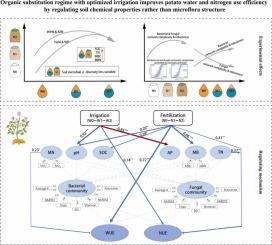当前位置:
X-MOL 学术
›
Field Crops Res.
›
论文详情
Our official English website, www.x-mol.net, welcomes your
feedback! (Note: you will need to create a separate account there.)
Organic substitution regime with optimized irrigation improves potato water and nitrogen use efficiency by regulating soil chemical properties rather than microflora structure
Field Crops Research ( IF 5.6 ) Pub Date : 2024-07-23 , DOI: 10.1016/j.fcr.2024.109512
Xiya Wang , Binggeng Yang , Lingling Jiang , Shicheng Zhao , Mengjiao Liu , Xinpeng Xu , Rong Jiang , Jun Zhang , Yu Duan , Ping He , Wei Zhou
Field Crops Research ( IF 5.6 ) Pub Date : 2024-07-23 , DOI: 10.1016/j.fcr.2024.109512
Xiya Wang , Binggeng Yang , Lingling Jiang , Shicheng Zhao , Mengjiao Liu , Xinpeng Xu , Rong Jiang , Jun Zhang , Yu Duan , Ping He , Wei Zhou

|
Improving water and fertilizer use efficiency is an inevitable choice for sustainable potato production in North China. However, the regulation mechanism of potato water and nitrogen use efficiency under water-nitrogen coupling (W-N) regime is still unknown. The objectives from a 3-year field experiment were (1) to assess the impact of W-N regimes on potato yield and water and nitrogen use efficiency, (2) to elucidate the soil microflora structure under W-N regimes, and (3) to determine the relationship between soil chemical properties, microflora structure, and potato water and nitrogen use efficiency. A three-year two-factor split-zone potato field experiment was conducted in arid and semi-arid regions of the Inner Mongolian Plateau, with irrigation [(rainfed (W0), optimized (soil-based) irrigation (W1), conventional irrigation (W2)] as the primary treatment and N fertilizer [no N (N0), chemical N (N1), 25 % manure substitution (N2)] as the secondary treatment. Potato yield and water productivity followed N2 > N1 > N0, and partial nitrogen productivity and nitrogen agronomic efficiency followed N2 > N1 at the same irrigation level. Potato yield, nitrogen internal efficiency, partial nitrogen productivity and nitrogen agronomic efficiency first increased and then decreased, whereas water productivity gradually decreased with increasing irrigation levels under the same fertilization regime. Moreover, potato yield, soil total nitrogen, organic carbon, and microbial biomass carbon and nitrogen content peaked with the W1N2 regime. W-N regimes significantly influenced soil microbial community structure. Soil microbial α-diversity was less variable under W1 and N2 conditions. Soil bacterial network complexity and robustness were higher in W1 and W2 than in W0 regimes, whereas the opposite was true for fungi. The complexity and robustness of the soil bacterial and fungal network demonstrated for three fertilization regimes were higher in N1 and N2 than in N0 regimes. Neutral community model showed that soil microflora in W-N regime was mainly influenced by stochastic processes. PLSPM showed that organic substitution regime with optimized irrigation improves potato water and nitrogen use efficiency by regulating soil chemical properties rather than microflora structure. W1N2 regime synergizes well to improve potato water and N use efficiency and soil microflora stability, and organic substitution regime with optimized irrigation improves potato water and nitrogen use efficiency by regulating soil chemical properties. Our findings initially clarified the regulatory mechanisms of potato water and nitrogen use efficiency in North China, offering theoretical guidance for further optimizing irrigation and fertilization management.
中文翻译:

优化灌溉的有机替代方案通过调节土壤化学性质而不是微生物区系结构来提高马铃薯水和氮的利用效率
提高水肥利用率是华北地区马铃薯可持续生产的必然选择。然而,水氮耦合(WN)条件下马铃薯水分和氮素利用效率的调节机制仍不清楚。为期 3 年的田间试验的目标是 (1) 评估 WN 制度对马铃薯产量以及水和氮利用效率的影响,(2) 阐明 WN 制度下的土壤微生物区系结构,以及 (3) 确定土壤化学性质、微生物区系结构与马铃薯水和氮利用效率之间的关系。在内蒙古高原干旱半干旱地区开展了为期三年的二因素分区马铃薯田间试验,灌溉方式为雨养(W0)、优化(土基)灌溉(W1)、常规灌溉。 (W2)]作为一级处理,氮肥[无氮(N0)、化学氮(N1)、25%粪肥替代(N2)]为二级处理,马铃薯产量和水分生产率依次为N2>N1>N0,并且。相同灌水水平下,氮素生产率和氮肥农艺效率均表现为N2>N1。在相同施肥水平下,马铃薯产量、氮素内部效率、氮肥偏产率和氮肥农学效率先上升后下降,而水分生产率则随着灌溉水平的增加而逐渐下降。此外,马铃薯产量、土壤总氮、有机碳和微生物生物量碳和氮含量在W1N2条件下达到峰值,显着影响土壤微生物群落结构。 W1 和 N2 条件下土壤微生物 α 多样性变化较小。 W1 和 W2 模式下的土壤细菌网络复杂性和鲁棒性高于 W0 模式,而真菌则相反。三种施肥方案中 N1 和 N2 的土壤细菌和真菌网络的复杂性和稳健性高于 N0 方案。中性群落模型表明WN区土壤微生物区系主要受随机过程的影响。 PLSPM表明,优化灌溉的有机替代方案通过调节土壤化学性质而不是微生物区系结构来提高马铃薯水和氮的利用效率。 W1N2 制度能够很好地协同提高马铃薯水和氮的利用效率以及土壤微生物区系的稳定性,而有机替代制度和优化灌溉通过调节土壤化学性质来提高马铃薯水和氮的利用效率。研究结果初步阐明了华北地区马铃薯水氮利用效率的调控机制,为进一步优化灌溉施肥管理提供理论指导。
更新日期:2024-07-23
中文翻译:

优化灌溉的有机替代方案通过调节土壤化学性质而不是微生物区系结构来提高马铃薯水和氮的利用效率
提高水肥利用率是华北地区马铃薯可持续生产的必然选择。然而,水氮耦合(WN)条件下马铃薯水分和氮素利用效率的调节机制仍不清楚。为期 3 年的田间试验的目标是 (1) 评估 WN 制度对马铃薯产量以及水和氮利用效率的影响,(2) 阐明 WN 制度下的土壤微生物区系结构,以及 (3) 确定土壤化学性质、微生物区系结构与马铃薯水和氮利用效率之间的关系。在内蒙古高原干旱半干旱地区开展了为期三年的二因素分区马铃薯田间试验,灌溉方式为雨养(W0)、优化(土基)灌溉(W1)、常规灌溉。 (W2)]作为一级处理,氮肥[无氮(N0)、化学氮(N1)、25%粪肥替代(N2)]为二级处理,马铃薯产量和水分生产率依次为N2>N1>N0,并且。相同灌水水平下,氮素生产率和氮肥农艺效率均表现为N2>N1。在相同施肥水平下,马铃薯产量、氮素内部效率、氮肥偏产率和氮肥农学效率先上升后下降,而水分生产率则随着灌溉水平的增加而逐渐下降。此外,马铃薯产量、土壤总氮、有机碳和微生物生物量碳和氮含量在W1N2条件下达到峰值,显着影响土壤微生物群落结构。 W1 和 N2 条件下土壤微生物 α 多样性变化较小。 W1 和 W2 模式下的土壤细菌网络复杂性和鲁棒性高于 W0 模式,而真菌则相反。三种施肥方案中 N1 和 N2 的土壤细菌和真菌网络的复杂性和稳健性高于 N0 方案。中性群落模型表明WN区土壤微生物区系主要受随机过程的影响。 PLSPM表明,优化灌溉的有机替代方案通过调节土壤化学性质而不是微生物区系结构来提高马铃薯水和氮的利用效率。 W1N2 制度能够很好地协同提高马铃薯水和氮的利用效率以及土壤微生物区系的稳定性,而有机替代制度和优化灌溉通过调节土壤化学性质来提高马铃薯水和氮的利用效率。研究结果初步阐明了华北地区马铃薯水氮利用效率的调控机制,为进一步优化灌溉施肥管理提供理论指导。




































 京公网安备 11010802027423号
京公网安备 11010802027423号